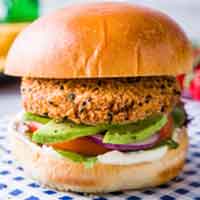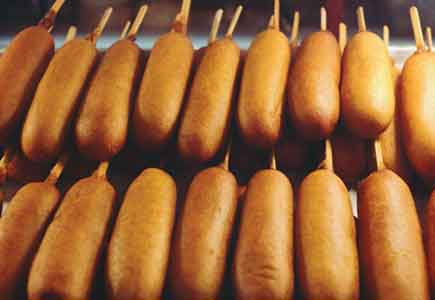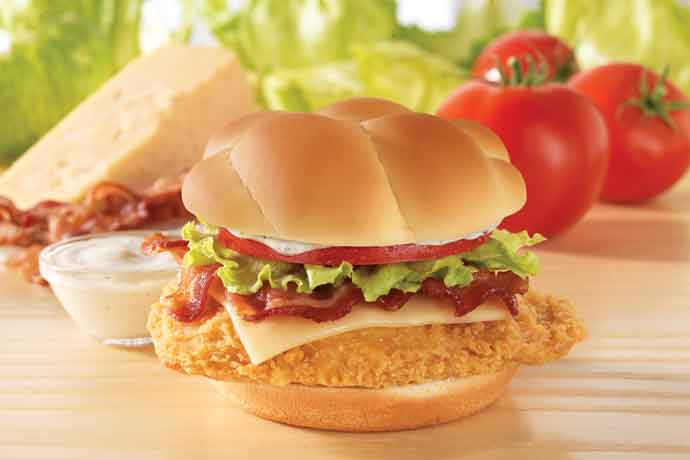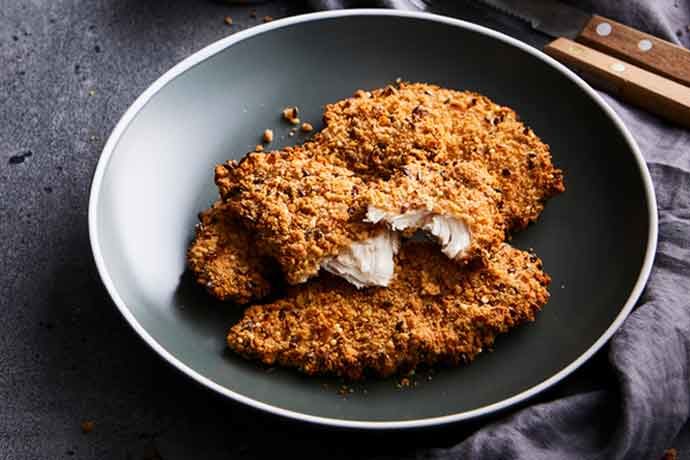Breading and batter technology invites meat and poultry processors to add an extra dimension of character to ordinary protein. These topical coatings can provide flavor, crunch and color. Some contribute whole grain nutrition, while others supply extra protein, heart-healthy fatty acids or fiber. Some simply make the protein more convenient, maybe even portable.
“If it’s edible, it’s breadable,” said Ralph Krawczyk, senior food scientist, Wixon Inc., St. Francis, Wis. “You can find a lot of innovation at state and county fairs. Maybe the world is ready for something other than a hot dog on a stick with a sweet corn batter. Pancake batters on breakfast sausage are already in the grocery store. There may be other proteins that could follow that concept.”
Think chicken kabob with a schnitzel breading. Try bratwurst on a stick with beer batter and hash brown potato breading. The possibilities are endless as suppliers get creative with their offerings.
“The best way to create innovation in this space is by layering in flavors from the substrate to the final batter or breading,” said Danny Bruns, director culinary-meat, Kerry, Beloit Wis.
For a Mediterranean flair, Bruns suggested marinating the protein in lemon garlic then using a chickpea flour pre-dust followed by a pretzel breading.
 “A breakfast protein can get an ‘everything bagel’ twist by including sesame seeds, onion flakes, poppy seeds, minced garlic, cracked pepper and sea salt in the breading,” Bruns said. “Or how about take a biscuit and gravy approach? Start with a sage and herb sausage. Apply a buttermilk batter followed with a homestyle-biscuit breading.”
“A breakfast protein can get an ‘everything bagel’ twist by including sesame seeds, onion flakes, poppy seeds, minced garlic, cracked pepper and sea salt in the breading,” Bruns said. “Or how about take a biscuit and gravy approach? Start with a sage and herb sausage. Apply a buttermilk batter followed with a homestyle-biscuit breading.”
Frozen appetizers and finger foods are all about layers of flavor and unique textures. Breadings encase everything from buffalo chicken chips to cheesy bacon fritters.
“Use a spicy citrus marinade on the protein, followed by rum in the batter and real coconut in the breading for a Caribbean crunch appetizer,” Bruns said. “All types of meat work with a Southwest or chipotle marinade. Then add some tomato flakes and cilantro to the pre-dust followed by a tortilla chip breading.”
Pretzel-crusted entrees have grown by 26% in the past four years, according to Datassential. This is followed by panko, peppercorn crusted and sesame crusted.
“Veggie-based coatings such as cauliflower and chickpea are starting to take off, with Kerry bringing to the market the first-ever cauliflower-coated chicken tender, which was launched in 2019,” said Amy Devitt, senior marketing specialist, meat, Kerry. “We are also seeing grain and seed coating innovations grow in popularity, as well as emerging fruit and vegetable flours, giving diet-restricted consumers more options and all consumers new sources of flavor, texture and protein.”
Newly Weds Foods, Chicago, now offers a range of flavorful breadcrumbs. The Hawaiian breadcrumbs are a rich, golden crumb with a slightly tropical sweet butter taste, like its popular namesake bread. The tender crumb gives pork and poultry bites a new twist, one that complements sweet and sour or sweet-heat dipping sauces.
New biscuit crumbs invoke a warm sense of nostalgia for consumers who grew up eating homemade buttermilk biscuits with sausage gravy, fried chicken or bacon and eggs. Memories of those flaky layers and melt-in-your-mouth texture are delivered in this unique crumb that contributes the nuance of Southern cooking to beef, pork and poultry. The crumbs, for example, add buttery richness to baked breaded chicken patties without all the frying oil fat calories.
Batter, breading and the pre-dust
Before getting creative with layers of flavors, it’s important to understand the function of batters, breadings and pre-dusts.
Batters are described as wet coatings. They are typically a mixture up to 90% flour and starch, along with a leavening agent (i.e., sodium bicarbonate, egg or even seltzer or beer), and water, oil and seasonings. Wheat flour is standard, with corn, potato, rice and soy flours becoming increasingly more common, in particular if gluten-free is a desired trait.
 When applied as the sole coating, batters are light by design. They require deep frying to set, as the high temperature of the oil causes the batter to blow up around the protein, preventing the protein from scorching while locking in flavors and juices. Upon cooling, the batter collapses, encasing the protein.
When applied as the sole coating, batters are light by design. They require deep frying to set, as the high temperature of the oil causes the batter to blow up around the protein, preventing the protein from scorching while locking in flavors and juices. Upon cooling, the batter collapses, encasing the protein.
Such flour batters – often described as tempura or fritter – are not to be confused with cornmeal batters. The latter are generously applied to the protein, usually hot dogs, and fry up to be crispy and crunchy. The density of the batter prevents it from expanding during frying.
Breadings, on the other hand, are dry coatings. They consist of particulates that stick to the surface of the protein. During cooking, which can be frying, baking or even stove top, the breading dries out instead of the protein it is covering, becoming crisp on the surface while helping the protein stay moist and tender.
Breadings can be as simple as a blend of wheat flour, corn starch and seasoning, or they can be based on bread or cracker crumbs and include granulated nuts and seeds, which bring texture, flavor and extra nutrition in the form of protein and fiber to the coating. Unlike batters with their soft texture, breadings are expected to have a gritty texture.
Many of today’s innovative encrusted proteins rely on larger granulation mixtures of different crumb types to develop unique textures and visual appeal. For example, panko, which is made from bread baked by passing an electric current through the dough in order to make bread without crust, has an airier texture compared to most other bread crumb types, which allows for a crispier finish.
Prior to the breading application, an ingredient system with adhesive properties is applied to keep the particulates in place. The system is usually determined by how the protein will be cooked.
If baking is the process, then adhesion is usually accomplished with help from a liquid coating. This may be an egg wash, a starch or gum solution, or an emulsion such as yogurt, mayonnaise or buttermilk.
“Batters can also be a liquid coating used to adhere breading to the protein,” said Erin Radermacher, senior technical services specialist, Cargill, Minneapolis. “Both breadings and batters create texture, add sensory appeal, and can even be used to enhance flavor. They also protect the meat during freezing and frying, helping to hold moisture for a juicer finished product.”
With batters and breadings intended for the fryer, the protein is often dusted with a flour-starch mixture before the covering is applied. This pre-dust is also where spices and flavors are added.
“Batters and breadings are commonly used together, where the protein is coated in a dry layer, followed by a wet layer,” said Dan Ramseyer, technical solutions analyst, Ardent Mills, Denver. “The pre-dust is the first layer added to the food product to help improve batter adhesion. The pre-dust is coated on the moist food surface before the wet batter layer is applied.”
George Manak, strategic marketing director, meat, Kerry, added, “Conceptually it’s pretty straightforward but the exciting challenge is to make all the layers work together in unison with the processing system.
“Flavor can be incorporated into any layer of the system; however, to prevent flash-off during frying, the closer the flavor is located to the protein, the better. The manufacturing and cooking processes are as critical to the performance of batters and breadings as the choice of ingredients.”
Troubleshooting tips

With so many ingredients and processes involved, it is helpful to know where to focus when specific issues arise. Adhesion is one of the more common challenges and one that must be addressed early on, as the whole purpose of batters and breadings is to adhere to the protein.
“Some adhesion issues reflect the substrate being used,” said June Qian, principal scientist for starch, meat, Kerry. “Surfaces that are dry or do not absorb moisture will need to go through a batter stage first and then you can apply a pre-dust that will absorb onto the batter.”
This is not typically an issue with meat. It is more common with vegetables and cheese.
“Achieving optimum adhesion is one of the big challenges with breadings and batters, especially in applications like bone-in chicken,” Radermacher said. “It can be difficult to get the coatings to stick evenly to the protein. Starches can help improve adhesion through frying and freezing, resulting in a more uniform final product.”
Cargill offers a line of batter starches developed with different adhesive and clear-coating functionalities to meet the demand for versatile coatings with high crispiness and optimal structural integrity. They provide consistent adhesion, uniform batter pick-up and deliver crispy, crunchy texture.
“In fried applications, the goal is to create a crispy product,” Radermacher said. “When fried products absorb too much oil, they become soggy and unappealing.”
Cargill offers starches and dextrins that create a protective film layer around the product. This reduces oil pick up and prevents oil from seeping into the breading.
Krawczyk said, “Batter adhesion may also be improved if protein, such as egg, milk or soy, is added to the pre-dust or batter system.”
The viscosity of batters used for adhesion is another place to troubleshoot.
“If it’s too thin, like the consistency of half and half, you’ll get little breading pickup,” Qian said. “If it’s too heavy, like a pancake batter, the coating may be too thick and you will have uncooked batter on the finished product.”
Radermacher agreed that viscosity of a batter is key for breading pickup and adhesion.
“Gums are used to help control the viscosity of batters, keeping them consistent throughout the manufacturing process and reducing run-off,” Radermacher said. “Gums also help suspend particulates like salt evenly throughout the mixture. They even help retain moisture during freezing, enabling proteins to retain succulent, juicy bite throughout the product’s shelf life. Xanthan gum is a popular choice for these applications.”
Batter viscosity can be monitored through a quality assurance step.
“This can be done by checking the flow of the batter with an instrument like a Bostwick consistometer or Zhan/Stein cup, sometimes called a D-cup,” Ramseyer said. “To account for the natural variation of the flours and starches in the formula, the amount of water added to hydrate the batter then can be adjusted to obtain the correct viscosity.”
Discoloration can typically be managed by adjustments in cooking time and temperature. Some discoloration cannot be controlled by the manufacturer.
Freeze-thaw during distribution and storage, for example, may result with moisture migrating to the surface. This may produce uneven surface browning and burning during frying, according to Qian.
“Blowouts (holes) in coating systems can be caused by ice crystals on the frozen protein surface,” Krawczyk said. “You need to eliminate these as much as possible. A strong adhesive batter system can help form a shell that is not easily broken.”
Consumers will often be disappointed when protein has excessive breading. This is quite common in chicken strips.
“Tailings of batter are generally caused by excess batter viscosity or equipment issues, such as air blow-off velocity, belt rates, etc.,” Krawczyk said.
Little extras
“A variety of flavors can be added to pre-dusts, batters and breadings,” Krawczyk said. “Generally, the more volatile flavors, such as cheese, mushroom and wine, do not survive long in a deep fryer, but other profiles such as Italian, curry, smoke, sautéed, grilled and spicy can be added successfully.
“Spices, such as paprika and whole herbs, may end up burning, so spice extractives may need to be used instead. Whole wheat and ancient grain batters are possible but can produce a darker finished color and possibly heavier texture. Seeds like fennel, anise, caraway and peppercorn, hold up well in the deep fryer. Natural colors will burn but artificial colors survive.”
With the rise in food delivery service, there’s a need to improve holding times of battered and breaded foods.
“Our customers are looking for ways to get a fried product to stay crisp from the restaurant to the consumer’s home,” Radermacher said. “Then there’s the holy grail of frozen convenience food. That’s to create a frozen chicken nugget that becomes crispy when microwaved.”
Briess Malt & Ingredients, Chilton, Wis., offers a range of ingredients for use in breaded and battered meat and poultry. Pure malt extracts, for example, add sweetness and color to batters and breadings. If the product is formulated to be gluten free, then white grain sorghum extract is a better choice. It’s a natural gluten-free sweetener distinguished by light color and a clean, wildflower honey-like flavor. It’s uniquely made by Briess from the starchy grain heads of white sorghum. Other sorghum syrups are typically produced from the cane of the red sorghum plant and have a harsh, bitter flavor and dark color, according to Wiwid Paramita, technical sales specialist.
“Pregelatinized flours have reduced cook times to save you time and input costs,” Paramita said. “They can be directly added into a batter for natural, healthy multigrain goodness, flavor and eye appeal. Pregelatinizing develops appealing flavor, eliminating any ‘raw grain’ taste.
“Pregelatinized flours also work well for dusting,” Paramita said. “For breadings, yellow dent corn grit adds texture. Dark roasted barley grits contribute color and can function as a pepper extender in breadings.”
Briess markets a pre-gelatinized brown rice flour that is ideal for tempura batters, according to Paramita.
“It’s gluten free and fries up into a light texture with just the right amount of crunch,” she said.
Laurie Scanlin, research and development director, Ardent Mills, said, “In recent internal testing of alternative flours, a small addition of quinoa flour is our top pick for use in traditional wheat-based batters. Quinoa performed the best overall when assessing batter viscosity, batter pick-up and sensory attributes. In particular, quinoa decreased oil absorption across a variety of substrates, including chicken, cheese and vegetables.
“In gluten-free batters, tapioca and rice flours are basic components. Incorporating ancient grains and legume flours can add richness and varying degrees of browning and textures. Chickpea, sorghum and red lentil flours are amongst our favorite additions. Chickpea flour performed the best overall in recent internal testing of gluten-free batters.”
Some recipe ideas from Scanlin include using puffed ancient grains, such as quinoa and sorghum crisps and flakes. They can be used instead of wheat-based panko for a variety of textures, flavors and product appearances, ranging from uniform to intentionally irregular, depending on the mix used.


